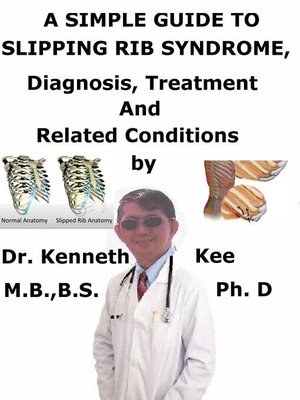A Simple Guide to Slipping Rib Syndrome, Diagnosis, Treatment and Related Conditions
ebook
By Kenneth Kee

Sign up to save your library
With an OverDrive account, you can save your favorite libraries for at-a-glance information about availability. Find out more about OverDrive accounts.
Find this title in Libby, the library reading app by OverDrive.



Search for a digital library with this title
Title found at these libraries:
| Library Name | Distance |
|---|---|
| Loading... |
This book describes Slipping Rib Syndrome, Diagnosis and Treatment and Related Disorders
Slipping rib syndrome happens when the costal cartilage securing ribs 8, 9 and 10, breaks, and allows the rib to sublux (partially dislocate), becoming hypermobile, and moving abnormally to cause pain in their chest or upper abdomen.
The disorder is slightly more frequent in women than men.
It has been documented in people as young as 12 years and as old as mid-80s but it mostly involves middle-aged people.
Overall, the syndrome is regarded as rare.
The precise cause of slipping rib syndrome is not well understood.
Slipping rib syndrome might happen after a trauma, injury, or surgery, but cases have been reported without any notable injuries.
Other causes are:
Congenital anomaly of the chest wall
The destruction of the fibrous articulation of the rib or their cartilage portion
Hyper-mobility of the costal cartilages of the false ribs
It is believed to be a result of hyper-mobility of the rib cartilage (costochondral) or ligaments, especially ribs 8, 9, and 10.
These three ribs are not attached to the sternum, but rather attached to each other by loose fibrous tissue.
They are occasionally called false ribs.
Due to this, they are most vulnerable to trauma, injury, or hyper-mobility.
This slippage or movement stimulates the nerves and may strain certain muscles in the area, causing inflammation and pain.
Ribs become slipping ribs due to hyper-mobility (too much motion) of the ribs at their attachment sites.
The underlying issue is believed to be due to injured or stretched ligaments that attach the ribs to both the spine and sternum.
This is often produced by seat belt injuries in car accidents, and collisions in contact sports.
It is very frequent for athletes involved in contact sports to get a slipped rib.
Traumatic injury produces stretching and occasionally tearing of the ligament attachments of the rib, creating instability of the rib.
Slipping ribs can produce many different types of pain.
Intermittent sharp stabbing pain in the upper abdomen or back, accompanied by a dull, achy sensation
Intermittent sharp stabbing pain in the upper back, mid-back, or even lower back
Slipping, popping, or clicking sensations in the lower ribs
Difficulty in breathing
Numbness in the arm or numbness around the chest or abdomen
Worsening of symptoms when bending, lifting, coughing, sneezing, deep breathing, stretching, or turning in bed
The diagnosis is made by a simple medical test-hooking maneuver, during which the doctor's fingers are placed under the affected rib margin and pulled forward.
If this duplicates the pain, clicking or a moving sensation the test is positive
A sonography, or ultrasound diagnostic imaging, can provide a fairly accurate depiction of where the ribs are presently placed.
Dynamic ultrasound of the ribs can be conducted with valsalva, coughing, twisting, crunch and push maneuvers to diagnose SRS.
Conservative Treatment involves:
Rest.
Avoiding strenuous activities.
Applying heat or ice to the affected area.
Oral medicines like NSAIDS.
Topical analgesics.
Physical Therapy - stretching and rotation exercises
Nerve blocks.
Non-conservative Treatment
If the disorder persists or produces severe pain, surgery may be advised.
The procedure or Partial rib resection has been an effective treatment for slipping rib syndrome.
Vertical rib plating with bio-absorbable plates reduced the rate of recurrence with early treatment.
TABLE OF...







